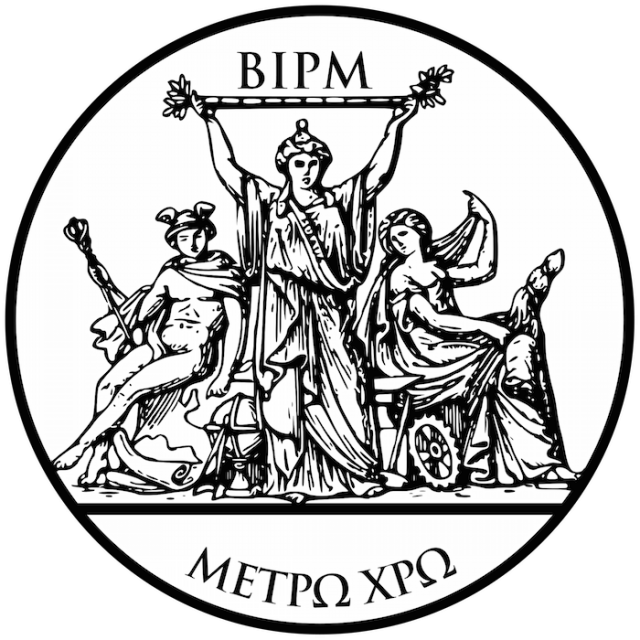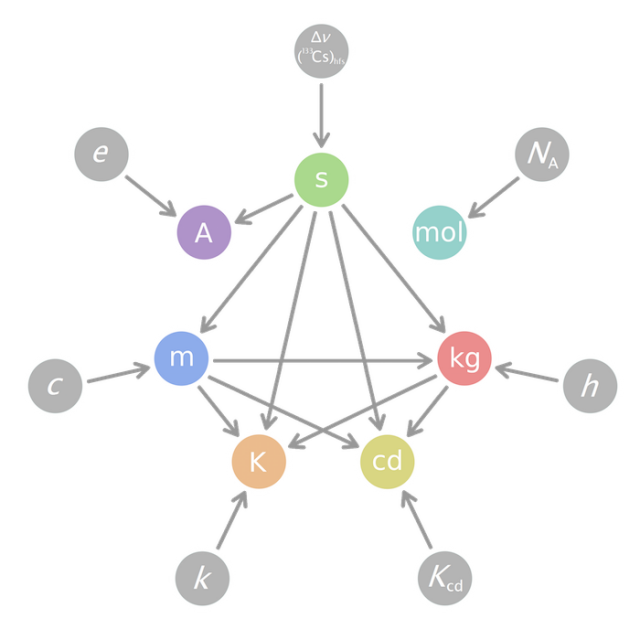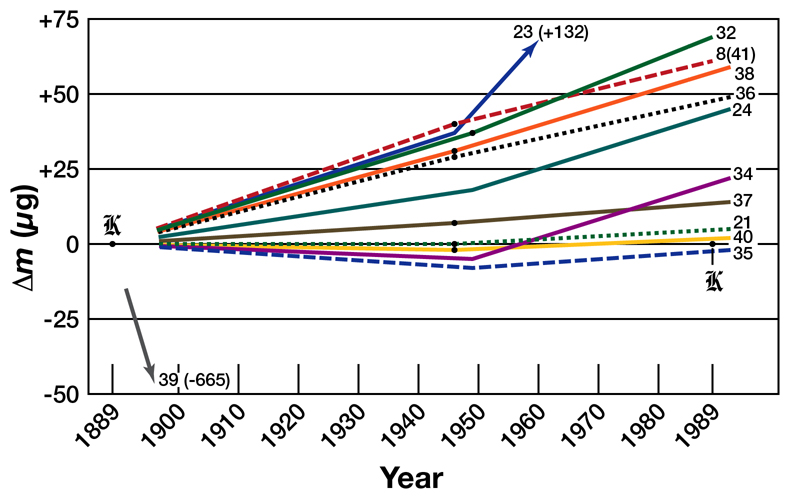The History of the Metric System: from the French Revolution to the SI

Image Credit: L. F. Labrousse (engraver). and J. P. Delion (publisher) via WikiCommons ( License )
One of the great under-appreciated stories of our growth in knowledge as a species is that of our development, in modern history, of a standardised mathematical language of measurement: the International System of Units, also known as the SI. Since at least the days of the 19th Century engineer Joseph Whitworth, who introduced some of the earliest widely-used engineering standards, there has been a consistent and necessary movement towards greater standardisation: the consolidation of existing standards into fewer, more rational ones, and the ever more widespread adoption of these rational standards. In Whitworth’s time, the problem was nonstandard fastener sizes causing unnecessary difficulties in the maintenance of steam engines (until 1841, the rail companies had all used different-sized screw threads, causing predictable frustration). Standardisation is, of course, unsexy, but it is a cornerstone of civilised existence in the age of industry, and it has become only more important since Whitworth’s day.
The story of the metric system starts, somewhat unexpectedly, in 17th Century England, with the proposal by the natural philosopher John Wilkins for a consistently decimal system of units. The Europe of his time was divided by the use of innumerable different systems of measure, with each country using its own traditional units (and in many cases, a lack of even national standardisation meant that different regions within countries would use their own measures). To remedy this, Wilkins conceived of a single, rational standard, based on the best science of his time, which all nations could equally share. His idea for a “universal Measure” was not adopted in his era, although that very phrase would ultimately (via Greek translation) give us the name of the metre. His proposed standard unit of length was defined by the length of a pendulum with half-period equal to one second; this length is extremely close to the modern definition of the metre (under standard gravity, it’s about 994 mm). The key advantage of his empirical definition was that, in principle, it would be equally easy to realise it anywhere on Earth – although due to local variations in the strength of Earth’s surface gravity, this experimental method is not ideal, and it has since been supplanted by more accurately reproducible methods.
During the Age of Enlightenment, with the growing momentum of scientific progress and the ever-greater necessity of international collaboration, the lack of a true standard of measurement became an increasing problem. In his works, Newton gave measurements such as the circumference of the Earth in French feet, as they were the closest approximation to a recognised international standard of measure that existed in his time.
However, it was only in France that the idea of the metre first encountered fertile cultural soil in which it could take root. Driven by a growing frustration at the chaos that had previously existed in the country (with many hundreds of thousands of units of measurement, varying from village to village, owing to the lack of true national standardisation), the French scientists of the late 18th Century created the first practically-implemented version of the metric system. This was the era of revolution, in which the ways of the old world were increasingly coming into question, and the atmosphere was perfect for new ideas to develop and flourish. In the words of the philosopher and mathematician Condorcet, it was intended to be “for all people, for all time” 1: a system that was defined in a logical and abstract mathematical way, not with respect to authority, tradition, local custom or human anatomy. In opposition to the traditional system’s horribly inconsistent mishmash of different fractions, the metric system would use only decimal fractions, and it would relate units at different scales by the use of decimal prefixes.
A great strength of the metric system, from a philosophical and scientific point of view, was its more abstract and general nature; rather than focussing on the sizes of specific objects (such as human feet) or specific instances of a measurement (such as the height of a column of mercury in a barometer), it concerned itself with the mathematical relationships between the measured quantities, relating them all to a simple set of units, which were intended to be derived from nature; thus the metre was originally 1/10 000 000 of the distance from the north pole to the equator, measured along the Paris meridian, and the kilogram was the mass of one cubic decimetre (or litre) of water. As with Wilkins’s “universal Measure”, the intention was to ensure that these unit definitions would, in principle, be accurately reproducible anywhere on Earth.
The new system did not meet an immediately warm welcome: whereas the revolutionary authorities were keen to promote it for reasons more political than practical, Napoleon was famously ambivalent towards it, purportedly dismissing it as “tormenting the people with trivia”. As a compromise, he introduced a system of mesures usuelles (“customary units”) throughout France, in which the traditional French units were redefined as rounded metric amounts (e.g. the traditional French pound or livre was redefined as 500 g). The downfall of Napoleon’s empire saw something of a resurgence of reactionary sentiment in France, and in this period the conservative writer Chateaubriand sniped at the new measures: “whenever you meet a fellow who, instead of talking arpents, toises and pieds [traditional French units], refers to hectares, metres and centimetres, rest assured, the man is a Prefect [i.e. a government official]”; his remarks set the tone for much of the opposition that the metric system has seen, according to which it is associated with officialdom, bureaucracy and elitism. Nonetheless, this phase proved transitional, and by the middle of the 19th Century the metrication of France was fundamentally completed. By the end of that century, the utility of the metric system had been widely recognised, and it had become the official measurement system of virtually all of continental Europe.
In the English-speaking world, by contrast, the new measures were much slower to take hold, initially because of the apathy of the British Empire and its hostility to the French Revolutionary and Napoleonic regimes. However, by the late 19th Century the great utility of the metric system in science and international commerce had become impossible to ignore, and in 1875 the major world powers, including the United States, signed the Treaty of the Metre, which gave the metric system its first official recognition as the international standard of measurement. Metre and kilogram prototypes were issued to the participating states to fix their national standards, and the world’s first international metrology organisation – the International Bureau of Weights and Measures, or BIPM – was created to oversee these standards.

Despite this, the British Empire still refused to adopt the new measures as its primary system, and thus a large part of the potential benefit of these newly-created standards was lost. Instead, the Empire maintained a version of the traditional English units which had been standardised in 1824 (i.e. the imperial system), and the US never adopted these revised definitions of the inch-pound units and continued to use the definitions which were current at the time of their independence (this is why the US gallon is so different from the imperial gallon). To ensure some sort of consistency, the standards for the older units were measured against the metric standards, and these “metricated” definitions were made official – for instance, the inch is now formally defined as 25.4 mm.
During the 20th Century, the metric units continued to become more widely adopted, most notably in science, a trend present even in the English-speaking world. At the same time, advances in measurement technology made it possible to increase the precision with which the units were defined: the second was redefined from 1/86 400 of a mean solar day to “the duration of 9 192 631 770 periods of the radiation corresponding to the transition between the two hyperfine levels of the ground state of the caesium 133 atom”. The metre, instead of being defined by a physical prototype (i.e. a platinum-iridium bar, which had originally been intended to have the length of one metre, but subsequently became the definitive standard of the metre) was defined by the speed of light, by using the above definition of the second and defining the speed of light to be 299 792 458 m/s exactly.
Introduction of the SI and world metrication
The most important step in the development of the metric system in the 20th Century was the creation of the International System of Units (i.e. the SI) in 1960: this was a rationalised version of the metre-kilogram-second (MKS) system, and it rendered obsolete the older CGS (centimetre-gram-second) and technical (or “gravitational”) metric systems. This took place in the age of reconstruction after World War II, a time in which international organisations such as the United Nations were being established, and the importance of international cooperation was becoming more widely appreciated. The SI was intended to become the sole system of measurement on Earth, a logical mathematical language that all nations could share alike, replacing the various systems of customary units that were still in use throughout the world, most notably in the English-speaking world.
Following the initial publication of the SI, the Commonwealth began its transition towards the new measurement system in the 1960s. Throughout the majority of it, the metrication process was smooth and quite painless; Australia formally announced that it had completely transitioned to the metric system in 1988. In other countries, the transition met with greater popular opposition: the Ford administration in the US passed a Metric Conversion Act in 1975, but it was never properly implemented, and the American public did not generally embrace the new measures. The Metric Board was abolished by Reagan, and replaced by a (fairly vacuous) statement that the SI was the US government’s “preferred system” of weights and measures. The outcome was that the country remained largely wedded to pounds, gallons, miles, feet and degrees Fahrenheit.
One of the most unfortunate illustrations of the failure of the US government’s approach to metrication was the Mars Climate Orbiter disaster, which was caused by confusion between different teams of engineers at NASA and Lockheed. Specifically, the NASA engineers were working in SI units, but Lockheed gave them thruster calibration information in pounds-force. When the NASA engineers instructed the orbiter to make a burn to decelerate into a 226 km orbit above Mars, they requested an impulse in newton-seconds, which the thruster control software interpreted in pound-force-seconds (i.e. approximately four times as much thrust as NASA intended). The result was that the probe descended into a 57 km orbit, and burned up in the Martian atmosphere.
Likewise in Canada there was the “Gimli glider”, an aircraft that ran out of fuel mid-flight because the ground crew had confused pounds and kilograms, and had thus given the aircraft less than half the requested amount of fuel. Cases like this arguably tell us that metrication, far from being an unnecessary luxury, is something we can ill-afford to neglect, and a half-hearted attitude towards it is most dangerous of all.
The UK’s attempts at metrication were ultimately more successful, though scarcely any more efficient. The original announcement of government metrication came in 1965 at the behest of British industry, and throughout the 1970s many aspects of British life – education, medicine, engineering and manufacturing – transitioned to the new system. Science, of course, had already been using metric units for many years. There was, however, comparatively little attempt to change the units used in daily British life, with the government adopting a comparatively relaxed and laissez-faire approach, especially in retail and transport. The metrication of road signs was originally intended to be complete by 1975, but this deadline kept slipping, in effect indefinitely postponing the transition to metric units on our roads.
One area in which there was (belated) success was the metrication of retail; as of 2000 all goods sold by weight or length had to be priced in metric units (confusingly, this never applied to description, so it is permissible to sell 2” by 4” timber, so long as it is priced per linear metre). An unintended side effect of this was the creation of so-called “metric martyrs” – traders who refused to weigh their goods in kilograms rather than pounds – but they ultimately lost their rebellion against weights and measures legislation, and today the use of metric units in British shops is largely uncontroversial.
This cultural process of metrication has had an interesting connection with Glasgow – both absolute temperature scales, the Kelvin scale (as used in the SI) and the Rankine scale (a version of the Fahrenheit scale that starts at absolute zero) originated in this city, and both are named after eminent professors of the University of Glasgow. Rankine penned a short poem on the metric system, the last verse of which reads:
A party of astronomers went measuring the Earth, And forty million metres they took to be its girth; Five hundred million inches, though, go through from Pole to Pole; So let’s stick to inches, feet and yards, and the good old three-foot rule.
In passing one might note that in order to convert “five hundred million inches” to miles, it is necessary to divide by 63 360, a bizarrely non-round number which serves as an exemplar of the cumbersome nature of calculations in imperial measure. It is perhaps a fitting metaphor that the two buildings of the University of Glasgow campus that are named after these two professors sit on opposing sides of Gilmorehill.
The outcome of the inconsistent and lukewarm attitude of our government towards the metric system was that the entire topic of metrication became quite toxic, with strong feelings on both sides, and little political will to do anything about it. But the notion that the metric system is fundamentally foreign to the English-speaking world, or Britain in particular, is a chimera. The original official international prototypes of the metre and kilogram were housed, as is well-known, in Paris, but they were manufactured in England. At virtually every stage of the development of the modern metric system, British scientists have had a great deal of involvement in this process, a legacy which is credited to the number of British scientists and engineers whose names are now the names of SI units – five (Newton, Joule, Faraday, Kelvin and Watt), a far greater number than for any other country.
What remains is for us to complete the transition to modern units of measure by addressing the remaining problematic areas – perhaps most especially our country’s weird aversion to kilometres, which puts us in perfect isolation from the rest of Europe (indeed, almost all of the world except for the US), including even our neighbours in Ireland. Our Department for Transport has stopped pretending that British people are almost uniquely incapable of understanding the units used on nearly all roads on Earth, and now merely claims that changing the road signs would be too expensive. A cynical commentator might even note that our government does not struggle to find money to maintain weapons of mass destruction, and the idea that one of the world’s largest economies would suffer any noticeable hardship by modernising its road signs (Australia, by contrast, switched on 1 July 1974 without incident) is an idea too silly to deserve serious comment. Serious problems have already been caused by vehicles from outside the UK repeatedly striking bridges, because their height is indicated only in imperial units – information which is hardly useful to non-British drivers. The further sad fact that certain misguided individuals have taken to vandalising road signs displaying metric units, and posting their criminal misbehaviour online, is all the more reason for an expedient conversion.
The New SI
An important technical improvement in the SI, as compared to the older versions of the metric system, was its coherency. This means that the units for different physical dimensions are inter-related in a logical manner, corresponding to the physical relationships between them. For example, Newton’s second law states that force is the product of mass and acceleration; thus, the SI unit of force (the newton) is equal to the product of the units of mass (the kilogram) and acceleration (the metre per second squared). From a set of seven base units, as shown in Fig. 3, it is possible to use this kind of dimensional analysis to derive any other SI unit. However, the original version of the system was incomplete in that, while the units themselves formed a coherent system in this way, their definitions did not. A new proposal, anticipated to be approved this year (2014), seeks to remedy this inconsistency.

Because of this proposal, this year is an especially important one for the SI, as it is anticipated that the CGPM (General Conference on Weights and Measures) will soon officially approve the largest overhaul of the system since its inception more than half a century ago. For the first time in our history, humanity will have one system of measurements in which all the units are defined with respect to the fundamental constants of nature, and not by physical prototypes such as metal bars or masses (as the kilogram now is, for example) or by a collection of very arbitrary experimental definitions, such as the calorie or the PS (“metric horsepower”). The key disadvantage of having a collection of different experimental definitions (for instance, having a unit of capacity which is unrelated to the unit of length, or power unrelated to energy) is that each experimental procedure is a source of uncertainty in the unit definition; with only the base units empirically defined, only those seven experimental errors need be considered.
A special case is the candela, which is something of an exception, in that it is defined with respect to the human sense of vision, which has occasionally caused controversy over its status as a base unit. The SI practice of naming many of its derived units after famous scientists has also been controversial, because it arguably seems to demonstrate a desire to create a “who’s who” of science for no objectively good reason (naming units after people is obviously a political matter), with a very conspicuous lack of women. By contrast, the older CGS units (used until the middle of the 20th Century) used more abstract unit names such as dyne, barye, and erg (derived from the Greek for “force”, “pressure” and “energy” respectively). Nonetheless, the status of the SI as the standard international language of metrology is now quite secure.

Fig. 4: Deviation in mass of the kilogram prototypes over time
Image Credit: Greg L via WikiCommons ( License )
The existing empirical definitions are inadequate because they are no longer representative of the precision of modern measurement techniques; in particular, the definition of the kilogram in terms of a metal cylinder in Paris (the International Prototype Kilogram or “Big K”) is problematic because of the cylinder’s slow change in mass over time, as shown in Fig. 4, causing it to deviate ever further from its own historical mass, as well as the masses of the other kilogram prototypes around the world. Moreover, improvements in measurement technology mean that new methods now allow the values of units to be defined with greater experimental precision. Everything in the SI will henceforth be inter-related in a logical way: a rational system appropriate for a world civilisation that derives its understanding of nature from science and reason, rather than from unexamined traditions and social conventions.
In particular, the proposed redefinition of the base units will see the kilogram, kelvin, mole and ampere redefined by fixing the Planck, Boltzmann and Avogadro constants, as well as the charge on the electron, respectively; the definitions of the metre, second and candela will be revised to bring them into accord. The new definitions will not change the size of the units (which would of course be very undesirable), but rather the experimental procedures by which those sizes are determined.
Throughout its eventful history, the metric system has been influenced by many factors, ranging from the scientific to the political. It is perhaps unexpected that a system of measures should be the subject of controversy, but standardisation on this scale is a task that humans have not previously attempted and it is unsurprising that we have encountered difficulties on the way. Ultimately, the benefits of the metric system and the standards associated with it, from millimetre-based screw threads to A4 paper, have become more and more widely appreciated through its history, and the system has prevailed over short-term opposition and even occasional attitudes of ignorance and prejudice. The SI is now firmly established as the standard international language of science and engineering, and it forms part of the broad foundation upon which all future human endeavours will be built.
The History of the Metric System: from the French Revolution to the SI by Gavin Kirby was specialist edited by Dominik Goetz and copy edited by Eloise Johnston.











I just learned more about the imperial system
I know this site presents quality based content and extra material, is there any other web page which offers such data in quality?
Pretty element of content. I just stumbled upon your site and in accession capital to claim that I get in fact enjoyed account your blog posts.
Any way I will be subscribing in your feeds and even I fulfillment you get right of entry to consistently quickly.
You have noted very interesting details! ps nice internet site.
Hi there,
I wanted to stop by and give my genuine feedback on your website. I really enjoyed to read your content, I think it’s interesting and very well written. I’ve been on your website for an hour or so and very enjoyed it.
I didn’t find your Instagram page though, do you have one?
Best,
David
Hi David, thanks for your message. our Instagram handle is @GlasgowGist (https://www.instagram.com/glasgowgist/)
All the best,
theGIST team
Hi there, always i useed to check weblog posts here early in the break of day, ass i love to
gain knowledge of more and more.
it is so good
way too long
I really like what you guys are up too. This sort of clever work and coverage!
Keep up the fantastic works guys I’ve added you guys to blogroll.